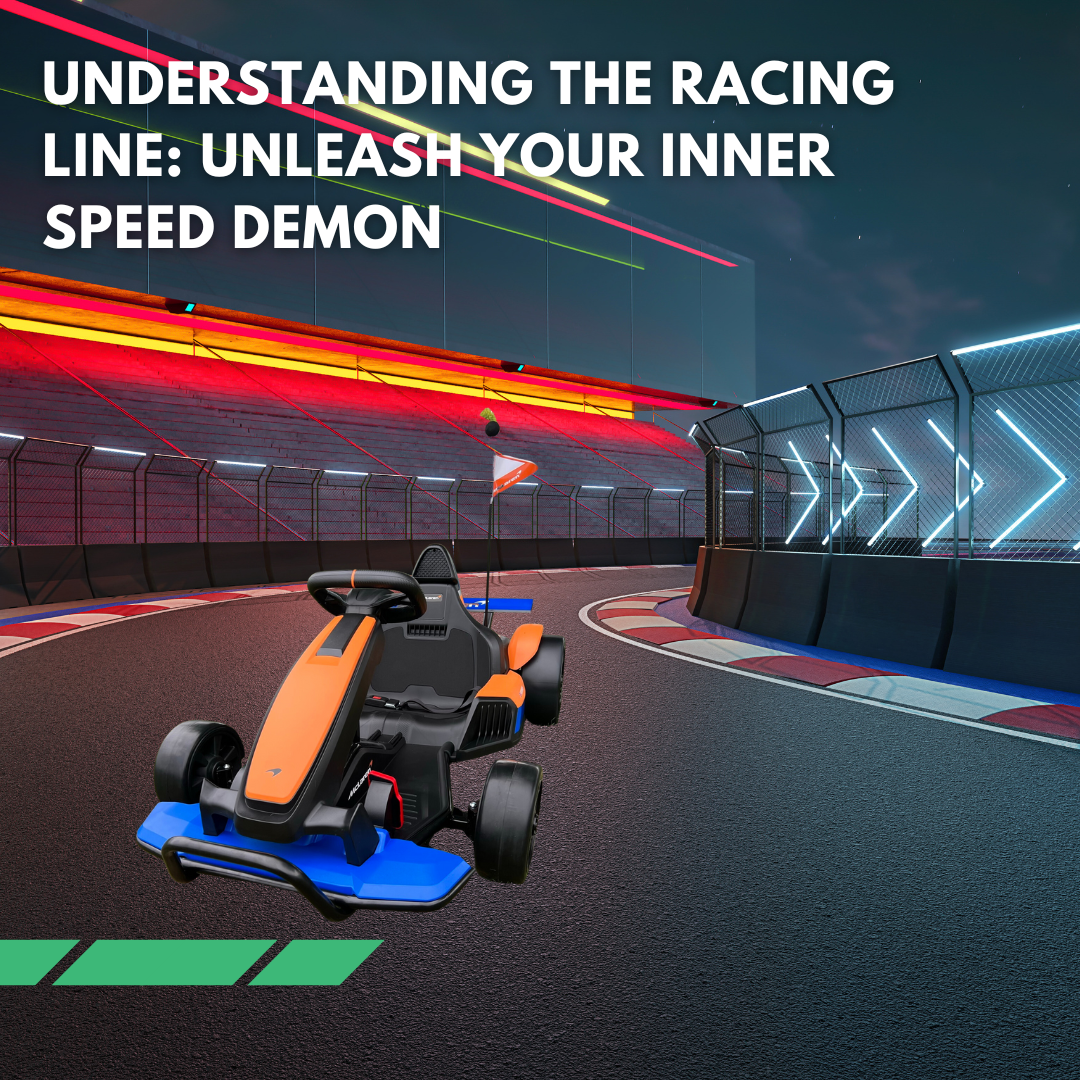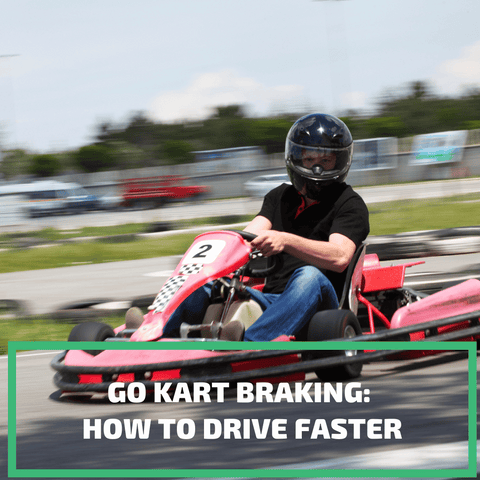Published: 5.7.23
Updated: 19.7.24
Picture this - you're behind the wheel, heart pounding with adrenaline, eyes on the track ahead.
Each corner you encounter seems to slow you down, stealing precious seconds from your lap time. But what if you had the perfect vehicle to maintain speed and control on these bends, like a high-quality go-kart?
Every twist and turn becomes a battle, a struggle to maintain speed and control. Wouldn't it be fantastic if there was a way to improve at this? Well, good news is, there's a whole guide on how to improve at go-karting waiting for you.
Could there be a secret to mastering these corners, to making them allies instead of adversaries? You might ask, why is go-karting good for me? Here's an article explaining the benefits of go-karting.
What if there was a way to maintain your speed, even accelerate smoothly out of these bends? The good news is, there is, and it's called the Racing Line.
But how much would a suitable go-kart cost?
Our guide on go-kart costs in the UK gives you a clear picture.
This powerful concept in motor racing is your key to unlocking faster, smoother laps. Get ready to dive in and unleash your inner speed demon.
Related: What is the Fastest Go Kart in the World?
The Short Answer to "Understanding the Racing Line"
The Racing Line is a fundamental concept in racing that enables drivers to maintain optimal speed and accelerate smoothly out of corners. It comprises four main sections - the braking point, turn-in point, apex, and exit point, each crucial for the vehicle's trajectory. Perfecting the racing line involves a deep understanding of the track, adapting to different corner types, and avoiding common mistakes like over-braking or late apexing. A master of the racing line utilises all available track space, brakes strategically, turns in at the right moment, and accelerates out of corners efficiently, thereby harnessing their inner speed demon.
What is the Racing Line?
The racing line is, quite simply, the fastest path a driver can take through a corner on a race circuit.
It's the golden route, so to speak, a driver follows to achieve the fastest possible speed.
The racing line isn't necessarily the shortest route; instead, it uses all of the available space on the track to facilitate a straighter line and increased speed.
The Concept Behind the Racing Line
Every corner, every turn, and every straight stretch on a race track is unique, and each demands a different approach.
The racing line is all about strategising and understanding these aspects.
It's about determining the optimal path, given the severity of the corner, the length of the following straight stretch, and the specific vehicle being driven.
The Four Main Sections of the Racing Line
There are four essential components of a racing line: the braking point, turn-in point, apex or clipping point, and the exit point.
These are the pillars that define the trajectory of your vehicle and determine your speed and success on the track.
Traversing the Racing Line: A Detailed Look
Now that we understand the concept behind the racing line let's delve into each section in detail.
Identifying and Utilising the Braking Point
This is the point where you brake to your vehicle's maximum capacity, shedding off speed to negotiate the corner safely and efficiently.
But remember, braking too early or too late can drastically affect your racing line and overall performance.
Navigating the Turn-In Point
The turn-in point is where you begin to steer your vehicle into the corner.
Your sight should already be fixed on the apex point, the target you aim to hit.
It's all about precision here; an early or late turn-in can have significant implications on your racing line.
Spotting and Making the Apex
The apex is the innermost point of the corner, the pinnacle of your trajectory.
Reaching it means you're midway through the corner and is the point where you should begin introducing the accelerator.
Perfecting the Exit Point
The exit point is where your vehicle leaves the corner and transitions into a straight line.
It's crucial to open up your steering towards the exit point, allowing your car to straighten and speed up.
Different Types of Racing Lines: Slow and Fast
Like many aspects of racing, the racing line isn't one-size-fits-all.
The racing line you choose largely depends on the corner's character.
There are two main types: the slow line and the fast line.
The Slow Line
The slow line, as the name suggests, is a slightly slower path but often considered safer.
It's typically employed by less experienced drivers or in situations where conserving tyres or fuel is essential.
The Fast Line
The fast line is the quickest route to drive any corner. It's a more aggressive approach, requiring precision and confidence, and often used when overtaking or setting a fast lap.
Beginner's Guide to Go-Karting
Go-kart racing is an exhilarating motorsport that offers a thrilling introduction to competitive driving. Here are the basics to get you started:
Getting Started
-
Try Rental Karting First: Begin with indoor or outdoor rental karts to get a feel for the sport without a significant investment. This allows you to practice basic skills and decide if you want to pursue it further.
-
Wear Appropriate Clothing: Choose comfortable, non-restrictive clothing and closed-toe shoes like trainers or runners. Avoid loose items that could get caught in the kart.
-
Learn Proper Positioning: Sit with your back flat against the seat, legs slightly bent to reach the pedals, and hands gripping the steering wheel at the quarter-to-three position. This ensures optimal control and comfort.
Driving Techniques
-
Master Pedal Control: Practice using the accelerator (right pedal) and brake (left pedal) smoothly. Never press both at the same time.
-
Be Smooth with Steering: Use gentle, precise movements on the steering wheel. Push the wheel rather than pulling it, with the outside hand applying 70% of the force.
-
Look Ahead: Always focus on where you want to go, not where you currently are. This helps you anticipate turns and react faster.
-
Brake Effectively: Apply firm pressure when braking before turns, then gradually release as you approach the apex.
-
Avoid Drifting: While it may look cool, drifting actually slows you down and wears out your tires faster.
Essential Driving Techniques for Go-Karting
Master Pedal Control
Accelerator: Use the right pedal smoothly.
Brake: Use the left pedal smoothly.
Tip: Never press both pedals at the same time.
Be Smooth with Steering
Steering Movements: Use gentle and precise movements.
Technique: Push the wheel rather than pulling it.
Hand Position: Outside hand should apply 70% of the force.
Look Ahead
Focus: Always look where you want to go.
Benefit: Helps anticipate turns and react faster.
Brake Effectively
Before Turns: Apply firm pressure on the brake.
Approaching Apex: Gradually release the brake.
Avoid Drifting
Myth: Drifting looks cool but is inefficient.
Reality: It slows you down and wears out tires faster.
Safety Tips
-
Listen to Staff Instructions: Pay close attention to the safety briefing and follow all rules and guidelines provided by track staff.
-
Maintain Safe Distances: Keep a safe distance from other karts and barriers to avoid collisions.
-
Use Safety Gear: Always wear the provided helmet and any other safety equipment offered by the track.
-
Stay Seated: Never stand up or attempt to exit the kart while on the track unless instructed by staff.
-
Signal If You Have Issues: Learn the proper hand signals to indicate if you're experiencing problems on the track.
Improving Your Skills
-
Practice Regularly: The more you drive, the better you'll become. Consider joining a local karting club for more opportunities to practice and race.
-
Study the Track: Before racing, familiarise yourself with the track layout, including turns and optimal racing lines.
-
Learn from Others: Watch and follow faster drivers to pick up techniques and racing lines.
-
Focus on Consistency: Aim for smooth, consistent laps rather than pushing too hard and making mistakes.
By following these tips and prioritising safety, you'll be well on your way to enjoying the exciting world of go-kart racing.
Remember to start slow, build your skills gradually, and most importantly, have fun!
| Tip | Description |
|---|---|
| Practice Regularly | The more you drive, the better you'll become. Consider joining a local karting club for more opportunities to practice and race. |
| Study the Track | Before racing, familiarise yourself with the track layout, including turns and optimal racing lines. |
| Learn from Others | Watch and follow faster drivers to pick up techniques and racing lines. |
| Focus on Consistency | Aim for smooth, consistent laps rather than pushing too hard and making mistakes. |
| Master Pedal Control | Practice using the accelerator (right pedal) and brake (left pedal) smoothly. Never press both at the same time. |
| Be Smooth with Steering | Use gentle, precise movements on the steering wheel. Push the wheel rather than pulling it, with the outside hand applying 70% of the force. |
| Look Ahead | Always focus on where you want to go, not where you currently are. This helps you anticipate turns and react faster. |
| Brake Effectively | Apply firm pressure when braking before turns, then gradually release as you approach the apex. |
| Avoid Drifting | While it may look cool, drifting actually slows you down and wears out your tires faster. |
The Unique Characteristics of a Karting Line
While the fundamentals remain the same, a karting line is a variation of the racing line specifically designed for go-karts.
Go-karts handle differently due to their unique design, resulting in a slightly different approach to braking points, turn-in points, apexes, and exit points.
How is a Karting Line Different from the Racing Line?
Go-karts are typically lighter and more agile than standard racing cars, influencing the approach to corners and the overall racing line.
In karting, late braking and early acceleration are more prevalent, altering the traditional racing line's dynamics.
Common Mistakes and How to Avoid Them
While mastering the racing line, it's easy to fall into some common traps.
Understanding these common mistakes can help avoid them and improve your race times.
Overbraking
Overbraking can significantly slow down your progress. Learn to modulate your brake pressure effectively to maintain an optimal speed through corners.
Late Apexing
Hitting the apex too late can cause you to lose speed and time. Practice timing your turns to hit the apex accurately.
Oversteering and Understeering
Both oversteering and understeering can throw off your racing line.
Learn to control your car's balance through corners to minimise these effects.
Tips and Tricks for Perfecting the Racing Line
Here are some tips and tricks to keep in mind as you master the racing line.
Visualisation
Before taking to the track, visualise the line you want to take.
Understanding the track layout can help you anticipate turns and straights, improving your racing line.
Consistency
Repetition is key to mastering the racing line. The more you practice, the more you'll understand how slight adjustments can impact your speed and time.
Adaptability
Remember that the racing line will change based on numerous factors such as weather conditions, tyre wear, and car performance.
Be ready to adapt your line as these factors change.
Adapt and Overcome: The Ever-Changing Nature of the Racing Line
The racing line is not a static entity. It requires constant readjustment and adaptation to changing conditions.
Things like track temperature, weather conditions, tyre wear, and fuel load can dramatically affect the optimal racing line, and it's up to the driver to respond accordingly.
Conclusion: Unleash Your Inner Speed Demon
Mastering the racing line is a journey filled with exhilaration, challenges, and incredible rewards.
From understanding the fundamentals, traversing the four main components - the braking point, turn-in point, apex, and exit point, to recognising the nuances of different racing lines, and even identifying the distinct characteristics of a karting line - we've covered it all.
Remember, common mistakes can be learning points, and they will gradually shape you into a better racer.
With practice, consistency, and adaptability, the racing line will become your ally on the track, paving the way for you to reach new speeds and achieve better lap times.
The race track is calling, and it's time for you to unleash your inner speed demon.
But remember, before hitting the track, it's essential to understand the maximum height for go-karting, and why go-karting can be expensive.
You can also explore some of our top ride-on drift cars for a change of pace. And remember, whether you're a beginner or a pro, enhancing your go-kart racing performance is always possible with the right guidance. Here's an article that can help you go from beginner to pro.
FAQs
How do different types of cars affect the racing line?
How do weather conditions affect the racing line?
What adjustments do drivers make to their racing line in hot weather?
During hot weather conditions, adjustments to the racing line are essential due to heat impacts on car performance. A wider entry into corners may be required to prevent tyre overheating and grip loss. Taking a later apex could help maintain speed through corners when tyres lose grip due to high track temperatures. A smoother driving style can enhance car control when tyres are overheated and grip is compromised.
Lastly, adjusting tyre pressures might be necessary to maintain optimal grip as air temperature increases causing tyre pressure to rise.
Happy racing!











Share:
Is Drifting a Kart Good for Speed? (UPDATED 2025)
Go Karting Tips & Tricks: How To Turn Corners Faster